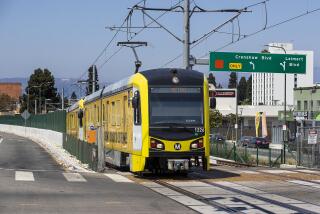Bus-Only Lanes Could Speed Riders, Slow Business
- Share via
Asefeh Shirafkan slumped in her seat on an MTA Rapid Bus as it rumbled down Wilshire Boulevard. Tired from a long day at work, she was resigned to a grinding, two-hour trip from West Los Angeles to Glendale that she described as thoroughly depressing.
But as she looked out the window at a thicket of gridlocked cars, her mood lightened. “I cannot believe how fast this bus is going,” said Shirafkan, an assistant at a mortgage company. “What a relief just to not be in that mess. Usually, the bus gets stuck in traffic.... It’s so, so bad.”
For a change, Shirafkan’s bus was zooming down Wilshire -- if only for a short stretch. That’s because the Metropolitan Transportation Authority is testing a plan to give buses a speed advantage over cars on Wilshire, one of the most traffic-clogged streets in the nation.
Last week, transit officials created rush-hour, bus-only lanes on a mile-long stretch of the boulevard -- from Federal Avenue to Centinela Avenue -- by taking away two lanes previously used for parking.
The theory is simple: Make buses faster, and people will ride. Get people out of their cars and congestion just might ease.
Wilshire Boulevard offers a good testing ground.
With about 50,000 people boarding buses on Wilshire Boulevard each weekday, ridership on the roughly 20-mile-long street is higher than on any other bus route in the region. Transit planners believe thousands more would climb on if the buses were able to run free from traffic.
Ultimately, planners would like to extend bus-only lanes from the ocean to downtown, with the lanes running down the middle of the boulevard.They plan to test the dedicated lanes on this stretch of street for about six months.
“We need to justify this, to prove that it can work well and speed up the trip,” said Rex Gephart, an MTA manager overseeing the test, which relies largely on street signs to keep motorists out of the lane. “We have to prove to people that we can get them from one end of the city to the other faster than in a car.”
Gephart conceded that bus-only lanes are a hard sell in Los Angeles, where the car is king and parking is good as gold to merchants.
Los Angeles has three dedicated bus lanes downtown, but none on the busy streets outside the city’s core. For the bus lane to be extended the full length of Wilshire Boulevard, which runs through Los Angeles, Beverly Hills and Santa Monica, the approval of all three city councils would be required.
On the stretch of Wilshire where the test is underway, some business owners are vowing to fight a move they see as capricious and shortsighted.
Many argue that the dedicated bus lane takes away parking that is extremely valuable to their customers, particularly from 4 to 7 p.m. when many shoppers make quick stops at the scores of small businesses there.
“This thing -- I’m worried it is going to kill my business,” said Sam Naimian, owner of SPC Wireless, a cell phone company. “Small businesses like the ones on this street -- we can’t afford to have a drop in customers. My business is down about 25% this week. If this keeps up, I will be done for in six to eight months.”
Naimian speculated that many of his customers will soon stop coming to his store, even though there is a small parking lot at the back of his business and parking on side streets off Wilshire. “People don’t like to be inconvenienced,” he said.
Some business owners complain that the agency did a poor job of informing people about the change, pointing to the fact that dozens of unwitting motorists have had their cars towed since the test started. Others doubt that the MTA will be able to extend the lane down most of Wilshire any time soon and wonder why they must go through the pain now.
Indeed, the MTA recently extended its timeline for building a full-fledged dedicated bus lane on Wilshire to about 2010. But officials say the project could be completed much sooner if the test proved to be a rousing success and local politicians got behind the idea. “It’s a sensitive issue,” Gephart said. “We’re just trying to see if it works.”
The dedicated lanes do have a few flaws. During parts of the rush-hour period, traffic flows fairly smoothly and the bus lanes don’t appear to provide much of an advantage to bus riders. The buses also can get caught up behind cars that can enter the lane to take a right turn.
But overall, from the MTA’s perspective, the early results seem promising.
When traffic gets severely clogged, the bus lane works exceedingly well. After 5 p.m. on a recent day, traffic was so bad that it took a reporter 30 minutes to drive the mile east from Centinela to Federal, meaning cars were moving at 2 mph. Meantime, several Rapid Buses quickly cut past the traffic and were soon gone from sight.
Bus riders favor the dedicated lane, happy to see themselves zooming past traffic. The most-often heard complaint: Why are officials waiting to extend the lane?
“Oh, they have to put this in; they just have to do it,” said Shirafkan, who doesn’t have a car. “Don’t the politicians know? The people want better and faster buses.... If we get that, I won’t have to buy a car. My trip home won’t be so bad.”
More to Read
Sign up for Essential California
The most important California stories and recommendations in your inbox every morning.
You may occasionally receive promotional content from the Los Angeles Times.











